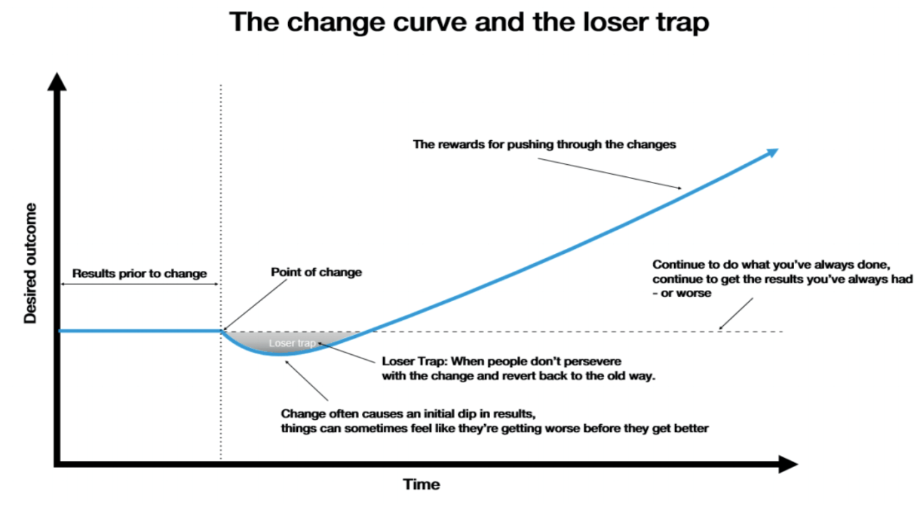By Shane Lukas, speaker, coach and MD of AVN Inspiring Accountants.
If your improvements aren’t improving things, you could be in the loser trap
Have you started a journey of change in your business but you feel like you’re not seeing progress? Or even that things are actually getting worse?
It’s demotivating, isn’t it? And it can also make you uncertain whether you should push on or just give up.
But you know as well as I do that change is necessary. If you don’t keep improving your business, you’ll stagnate. New technologies and new approaches are continually being developed and if you don’t adopt them, your competitors will. And as they become more efficient or provide greater value for money or simply sell a better product, your business starts to look dated.
What is the loser trap?
With any change there is inevitably a dip before the great results arrive.
Change can be both exciting and scary (for some that balance will shift one way or the other), but the initial dip in results can knock your confidence.
A common reaction in this situation is to feel you have to abandon your new course of action and revert back to the norm, the old way of doing things, because it worked and you trusted that approach.
This period of uncertainty and worry is known as the loser trap.
You can see where it occurs in this illustration of the change curve. And actually, simply being aware that this is normal can be a great comfort.
 Ask yourself the question, where on that dip are you right now?
Ask yourself the question, where on that dip are you right now?
If your results have been getting worse but this has now levelled off, then perhaps you’re simply at the bottom of the dip and things will soon improve. If you’re still seeing a drop in results then maybe you’re still in the early stages of the loser trap.
The big question is of course … is the change you’re making going to make things better or is it actually a poor course of action?
How do you know? And when is the right time to pull out? Should you pull out or make tweaks to your approach?
A few questions to ask yourself… and answer honestly
Is your new tactic/strategy tried and tested or is it a totally new approach?
What’s causing the dip in your results? Is it a lack of confidence or current abilities that training and perseverance will resolve? Have all of your team fully adopted the new method or is take up only partial, which may be affecting the results?
Is the reason for the dip because you’ve changed something to free up your time but you’ve yet to fill that time more efficiently?
What was the reason for making this change? Was it just a knee jerk reaction to something that happened or was there a strong reason behind it?
How to make it through the loser trap
Be careful who you talk to about this. There will always be the sceptics and the pessimists who will tell you that you shouldn’t have changed anything in the first place.
Conversely, being overly optimistic and pushing on with hope alone won’t always get you the results you desire either.
Getting an external opinion can help. So talk to a coach. A professional coach won’t lead you, or influence you but will ask you the right questions to get you to consider the situation objectively. They can often bring their own experience to the table too, to help you decide whether to continue, tweak or abandon.
What Key Performance Measures do you have in place to ensure you’re tracking the success of your strategy?
Are you carrying out the proven strategy in exactly the way it’s intended, or have you modified it to suit your comfort zone?
An example of how NOT to do it
Recently I shared a strategy for taking control of referrals with a new coaching client of mine. His existing clients were occasionally sending him referrals but they weren’t always the type of client he really wanted.
I told him about a strategy that I know works incredibly well. It’s helped other businesses grow from 5 figures to 7 figures revenue in a handful of years by increasing their client base with just the right type of client.
However, when I checked in with him 2 weeks later and asked him how the strategy had gone, he said it hadn’t worked. When I drilled a little further, I discovered that he had changed the approach I’d described because he wasn’t comfortable with it. But if you switch coffee for flour in a bread recipe, you’re not going to get a great loaf of bread. Likewise, if you’re using a trusted, proven method but you’re tweaking it, you’re not going to get the results you’d like.
To reduce the impact of the change curve, start small and test your new approach on a small sample.
Track your progress and break down the key results into measurable subsets so that you can see what’s going on in more detail. Limit the exposure of your new approach if possible and set yourself a date to review the results.
I know how hard this can be. But it’s so worth it when you see your results start to improve.
There are more strategies to make change happen in your accountancy practice in Putting Excellence Into Practice, my best-selling book that gives you a roadmap for improving the way you do things. Download your free copy here.
Photo by Muhammad Daudy on Unsplash
Recent Comments